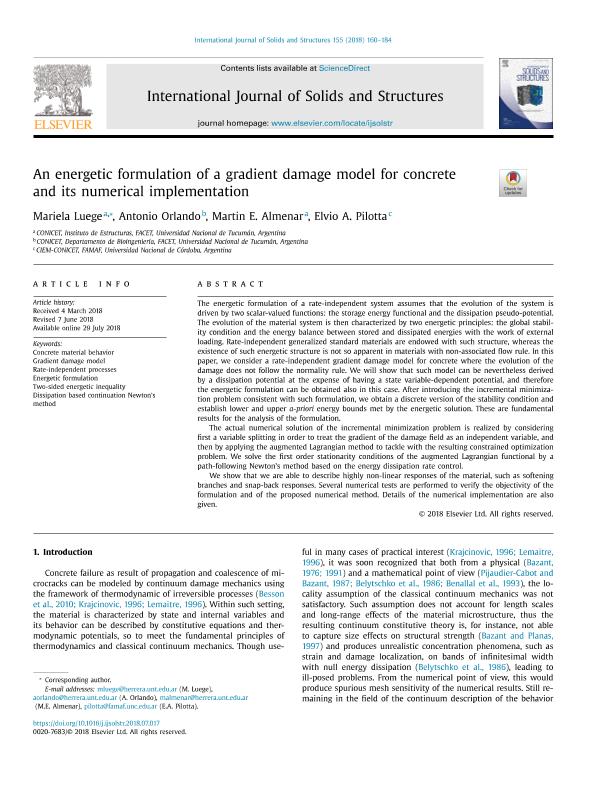Mostrar el registro sencillo del ítem
dc.contributor.author
Luege, Mariela

dc.contributor.author
Orlando, Antonio

dc.contributor.author
Almenar, Martín Ernesto

dc.contributor.author
Pilotta, Elvio Angel

dc.date.available
2019-10-10T14:35:12Z
dc.date.issued
2018-12
dc.identifier.citation
Luege, Mariela; Orlando, Antonio; Almenar, Martín Ernesto; Pilotta, Elvio Angel; An energetic formulation of a gradient damage model for concrete and its numerical implementation; Pergamon-Elsevier Science Ltd; International Journal Of Solids And Structures; 155; 12-2018; 160-184
dc.identifier.issn
0020-7683
dc.identifier.uri
http://hdl.handle.net/11336/85493
dc.description.abstract
The energetic formulation of a rate-independent system assumes that the evolution of the system is driven by two scalar-valued functions: the storage energy functional and the dissipation pseudo-potential. The evolution of the material system is then characterized by two energetic principles: the global stability condition and the energy balance between stored and dissipated energies with the work of external loading. Rate-independent generalized standard materials are endowed with such structure, whereas the existence of such energetic structure is not so apparent in materials with non-associated flow rule. In this paper, we consider a rate-independent gradient damage model for concrete where the evolution of the damage does not follow the normality rule. We will show that such model can be nevertheless derived by a dissipation potential at the expense of having a state variable-dependent potential, and therefore the energetic formulation can be obtained also in this case. After introducing the incremental minimization problem consistent with such formulation, we obtain a discrete version of the stability condition and establish lower and upper a-priori energy bounds met by the energetic solution. These are fundamental results for the analysis of the formulation. The actual numerical solution of the incremental minimization problem is realized by considering first a variable splitting in order to treat the gradient of the damage field as an independent variable, and then by applying the augmented Lagrangian method to tackle with the resulting constrained optimization problem. We solve the first order stationarity conditions of the augmented Lagrangian functional by a path-following Newton's method based on the energy dissipation rate control. We show that we are able to describe highly non-linear responses of the material, such as softening branches and snap-back responses. Several numerical tests are performed to verify the objectivity of the formulation and of the proposed numerical method. Details of the numerical implementation are also given.
dc.format
application/pdf
dc.language.iso
eng
dc.publisher
Pergamon-Elsevier Science Ltd

dc.rights
info:eu-repo/semantics/openAccess
dc.rights.uri
https://creativecommons.org/licenses/by-nc-sa/2.5/ar/
dc.subject
CONCRETE MATERIAL BEHAVIOR
dc.subject
DISSIPATION BASED CONTINUATION NEWTON'S METHOD
dc.subject
ENERGETIC FORMULATION
dc.subject
GRADIENT DAMAGE MODEL
dc.subject
RATE-INDEPENDENT PROCESSES
dc.subject
TWO-SIDED ENERGETIC INEQUALITY
dc.subject.classification
Ingeniería Estructural

dc.subject.classification
Ingeniería Civil

dc.subject.classification
INGENIERÍAS Y TECNOLOGÍAS

dc.title
An energetic formulation of a gradient damage model for concrete and its numerical implementation
dc.type
info:eu-repo/semantics/article
dc.type
info:ar-repo/semantics/artículo
dc.type
info:eu-repo/semantics/publishedVersion
dc.date.updated
2019-08-30T14:27:41Z
dc.journal.volume
155
dc.journal.pagination
160-184
dc.journal.pais
Estados Unidos

dc.description.fil
Fil: Luege, Mariela. Universidad Nacional de Tucumán. Facultad de Ciencias Exactas y Tecnología. Instituto de Estructuras "Ing. Arturo M. Guzmán"; Argentina. Consejo Nacional de Investigaciones Científicas y Técnicas; Argentina
dc.description.fil
Fil: Orlando, Antonio. Universidad Nacional de Tucumán. Facultad de Ciencias Exactas y Tecnología. Departamento de Bioingeniería; Argentina. Consejo Nacional de Investigaciones Científicas y Técnicas; Argentina
dc.description.fil
Fil: Almenar, Martín Ernesto. Universidad Nacional de Tucumán. Facultad de Ciencias Exactas y Tecnología; Argentina. Consejo Nacional de Investigaciones Científicas y Técnicas; Argentina
dc.description.fil
Fil: Pilotta, Elvio Angel. Universidad Nacional de Córdoba. Facultad de Matemática, Astronomía y Física; Argentina. Consejo Nacional de Investigaciones Científicas y Técnicas. Centro Científico Tecnológico Conicet - Córdoba. Centro de Investigación y Estudios de Matemática. Universidad Nacional de Córdoba. Centro de Investigación y Estudios de Matemática; Argentina
dc.journal.title
International Journal Of Solids And Structures

dc.relation.alternativeid
info:eu-repo/semantics/altIdentifier/url/https://www.sciencedirect.com/science/article/pii/S0020768318303007
dc.relation.alternativeid
info:eu-repo/semantics/altIdentifier/doi/https://doi.org/10.1016/j.ijsolstr.2018.07.017
Archivos asociados
